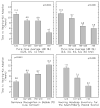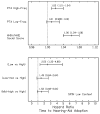Time From Hearing Aid Candidacy to Hearing Aid Adoption: A Longitudinal Cohort Study
- PMID: 30085938
- PMCID: PMC6363915
- DOI: 10.1097/AUD.0000000000000641
Time From Hearing Aid Candidacy to Hearing Aid Adoption: A Longitudinal Cohort Study
Abstract
Objectives: Although many individuals with hearing loss could benefit from intervention with hearing aids, many do not seek or delay seeking timely treatment after the onset of hearing loss. There is limited data-based evidence estimating the delay in adoption of hearing aids with anecdotal estimates ranging from 5 to 20 years. The present longitudinal study is the first to assess time from hearing aid candidacy to adoption in a 28-year ongoing prospective cohort of older adults, with the additional goal of determining factors influencing delays in hearing aid adoption, and self-reported successful use of hearing aids.
Design: As part of a longitudinal study of age-related hearing loss, a wide range of demographic, biologic, and auditory measures are obtained yearly or every 2 to 3 years from a large sample of adults, along with family, medical, hearing, noise exposure, and hearing aid use histories. From all eligible participants (age ≥18; N = 1530), 857 were identified as hearing aid candidates either at baseline or during their participation, using audiometric criteria. Longitudinal data were used to track transition to hearing aid candidacy and hearing aid adoption. Demographic and hearing-related characteristics were compared between hearing aid adopters and nonadopters. Unadjusted estimated overall time (in years) to hearing aid adoption and estimated delay times were stratified by demographic and hearing-related factors and were determined using a time-to-event analysis (survival analysis). Factors influencing rate of adoption in any given time period were examined along with factors influencing successful hearing aid adoption.
Results: Age, number of chronic health conditions, sex, retirement status, and education level did not differ significantly between hearing aid adopters and nonadopters. In contrast, adopters were more likely than nonadopters to be married, of white race, have higher socioeconomic status, have significantly poorer higher frequency (2.0, 3.0, 4.0, 6.0, and 8.0 kHz) pure-tone averages, poorer word recognition in quiet and competing multi-talker babble, and reported more hearing handicap on the Hearing Handicap Inventory for the Elderly/Adults emotional and social subscales. Unadjusted estimation of time from hearing aid candidacy to adoption in the full participant cohort was 8.9 years (SE ± 0.37; interquartile range = 3.2-14.9 years) with statistically significant stratification for race, hearing as measured by low- and high-frequency pure-tone averages, keyword recognition in low-context sentences in babble, and the Hearing Handicap Inventory for the Elderly/Adults social score. In a subgroup analysis of the 213 individuals who adopted hearing aids and were assigned a success classification, 78.4% were successful. No significant predictors of success were found.
Conclusions: The average delay in adopting hearing aids after hearing aid candidacy was 8.9 years. Nonwhite race and better speech recognition (in a more difficult task) significantly increased the delay to treatment. Poorer hearing and more self-assessed hearing handicap in social situations significantly decreased the delay to treatment. These results confirm the assumption that adults with hearing loss significantly delay seeking treatment with hearing aids.
Figures





References
-
- Bilger RC. Manual for the clinical use of the Speech Perception in Noise (SPIN) Test. Champaign-Urbana: University of Illinois; 1984.
Publication types
MeSH terms
Grants and funding
LinkOut - more resources
Full Text Sources
Other Literature Sources
Medical
Research Materials

